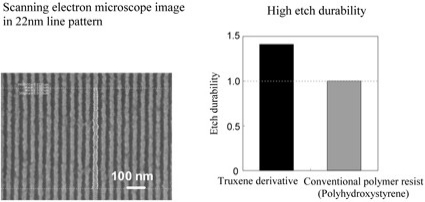November 18, 2009 – Toshiba Corp. says it has developed a high-resolution photoresist specifically for extreme ultraviolet (EUV) lithography in semiconductor fabrication, viable to 20nm process technology.
The achievement, which will be disclosed in more detail at this week’s International Microprocesses and Nanotechnology Conference, addresses the need to come up with a low-molecular material for photoresist once ArF laser exposure and conventional polymer photoresists are unable to achieve required resolutions, starting around the 20nm node, which according to the International Technology Roadmap for Semiconductors (ITRS) would be around 2013.
Toshiba’s work centers on a derivative of truxene, which it has applied to positive tone process (area exposed to light source removed from wafer) and then to negative tone process (area not exposed is removed, leaving the raised pattern area), to form a "20nm-scale generation" test pattern. Negative photoresist performance was optimized by balancing the truxene derivative and a cross-linker, the company says — the cross-linker and a photo-acid generator are required to connect the molecules through chemical reaction, with a optimized compound ratio (3:1, says Toshiba) achieved according to light transmittance and reaction speed.


